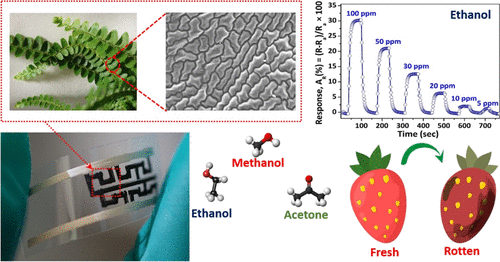Our official English website, www.x-mol.net, welcomes your feedback! (Note: you will need to create a separate account there.)
Fractal Design for Advancing the Performance of Chemoresistive Sensors
ACS Sensors ( IF 8.9 ) Pub Date : 2021-10-13 , DOI: 10.1021/acssensors.1c01449 Kamrul Hassan 1, 2 , Tran Thanh Tung 1, 2 , Pei Lay Yap 1, 2 , Hadi Rastin 1, 2 , Nathan Stanley 1, 2 , Md Julker Nine 1, 2 , Dusan Losic 1, 2
ACS Sensors ( IF 8.9 ) Pub Date : 2021-10-13 , DOI: 10.1021/acssensors.1c01449 Kamrul Hassan 1, 2 , Tran Thanh Tung 1, 2 , Pei Lay Yap 1, 2 , Hadi Rastin 1, 2 , Nathan Stanley 1, 2 , Md Julker Nine 1, 2 , Dusan Losic 1, 2
Affiliation

|
The rapid advancement of internet of things (IoT)-enabled applications along with connected automation in sensing technologies is the heart of future intelligent systems. The probable applications have significant implications, from chemical process monitoring to agriculture, mining, space, wearable electronics, industrial manufacturing, smart cities, and point-of-care (PoC) diagnostics. Advancing sensor performance such as sensitivity to detect trace amounts (ppb–ppm) of analytes (gas/VOCs), selectivity, portability, and low cost is critical for many of these applications. These advancements are mainly achieved by selecting and optimizing sensing materials by their surface functionalization and/or structural optimization to achieve favorable transport characteristics or chemical binding/reaction sites. Surprisingly, the sensor geometry, shapes, and patterns were not considered as critical parameters, and most of these sensors were designed by following simple planar and interdigitated electrode geometry. In this study, we introduce a new bioinspired fractal approach to design chemoresistive sensors with fractal geometry, which grasp the architecture of fern leaves represented by the geometric group of space-filling curves of fractal patterns. These fractal sensors were printed by an extrusion process on a flexible substrate (PET) using specially formulated graphene ink as a sensing material, which provided significant enhancement of the active surface area to volume ratio and allowed high-resolution fractal patterning along with a reduced current transportation path. To demonstrate the advantages and influence of fractal geometry on sensor performance, here, three different kinds of sensors were fabricated based on different fractal geometrics (Sierpinski, Peano, and Hilbert), and the sensing performance was explored toward different VOC analytes (e.g., ethanol, methanol, and acetone). Among all these fractal-designed sensors including interdigitate sensors, the Hilbert-designed printed sensor shows enhanced sensing properties in terms of fast response time (6 s for 30 ppm), response value (14%), enhanced detection range (5–100 ppm), high selectivity, and low interference to humidity (up to RH 80%) for ethanol at room temperature (20 °C). Moreover, a significant improvement of this sensor performance was observed by applying the mechanical deformation (positive bending) technique. The practical application of this sensor was successfully demonstrated by monitoring food spoilage using a commercial box of strawberries as a model. Based on these presented results, this biofractal biomimetic VOC sensor is demonstrated for a prospective application in food monitoring.
中文翻译:

用于提高化学电阻传感器性能的分形设计
物联网 (IoT) 应用的快速发展以及传感技术中的互联自动化是未来智能系统的核心。可能的应用具有重大意义,从化学过程监控到农业、采矿、太空、可穿戴电子产品、工业制造、智能城市和即时 (PoC) 诊断。提高传感器性能,例如检测痕量 (ppb-ppm) 分析物(气体/VOC)的灵敏度、选择性、便携性和低成本,对于许多此类应用至关重要。这些进步主要是通过选择和优化传感材料的表面功能化和/或结构优化来实现的,以实现有利的传输特性或化学结合/反应位点。令人惊讶的是,传感器的几何形状、形状、和图案不被视为关键参数,并且大多数这些传感器是通过遵循简单的平面和交叉电极几何形状设计的。在这项研究中,我们引入了一种新的仿生分形方法来设计具有分形几何形状的化学电阻传感器,该方法掌握了由分形图案的空间填充曲线几何组表示的蕨叶结构。这些分形传感器使用特殊配方的石墨烯墨水作为传感材料,通过挤压工艺印刷在柔性基板 (PET) 上,显着提高了活性表面积与体积之比,并允许高分辨率分形图案以及降低的电流运输路径。为了展示分形几何对传感器性能的优势和影响,这里,基于不同的分形几何(Sierpinski、Peano 和 Hilbert)制造了三种不同类型的传感器,并探索了对不同 VOC 分析物(例如乙醇、甲醇和丙酮)的传感性能。在所有这些分形设计的传感器(包括叉指传感器)中,希尔伯特设计的印刷传感器在快速响应时间(6 秒,30 ppm)、响应值 (14%)、增强的检测范围(5-100 ppm)方面显示出增强的传感特性)、高选择性和对室温 (20 °C) 乙醇的低湿度干扰(高达 RH 80%)。此外,通过应用机械变形(正弯曲)技术,观察到该传感器性能的显着改善。通过使用商业草莓盒作为模型监测食物腐败,成功地证明了该传感器的实际应用。基于这些呈现的结果,这种生物分形仿生 VOC 传感器被证明可用于食品监测中的前瞻性应用。
更新日期:2021-10-22
中文翻译:

用于提高化学电阻传感器性能的分形设计
物联网 (IoT) 应用的快速发展以及传感技术中的互联自动化是未来智能系统的核心。可能的应用具有重大意义,从化学过程监控到农业、采矿、太空、可穿戴电子产品、工业制造、智能城市和即时 (PoC) 诊断。提高传感器性能,例如检测痕量 (ppb-ppm) 分析物(气体/VOC)的灵敏度、选择性、便携性和低成本,对于许多此类应用至关重要。这些进步主要是通过选择和优化传感材料的表面功能化和/或结构优化来实现的,以实现有利的传输特性或化学结合/反应位点。令人惊讶的是,传感器的几何形状、形状、和图案不被视为关键参数,并且大多数这些传感器是通过遵循简单的平面和交叉电极几何形状设计的。在这项研究中,我们引入了一种新的仿生分形方法来设计具有分形几何形状的化学电阻传感器,该方法掌握了由分形图案的空间填充曲线几何组表示的蕨叶结构。这些分形传感器使用特殊配方的石墨烯墨水作为传感材料,通过挤压工艺印刷在柔性基板 (PET) 上,显着提高了活性表面积与体积之比,并允许高分辨率分形图案以及降低的电流运输路径。为了展示分形几何对传感器性能的优势和影响,这里,基于不同的分形几何(Sierpinski、Peano 和 Hilbert)制造了三种不同类型的传感器,并探索了对不同 VOC 分析物(例如乙醇、甲醇和丙酮)的传感性能。在所有这些分形设计的传感器(包括叉指传感器)中,希尔伯特设计的印刷传感器在快速响应时间(6 秒,30 ppm)、响应值 (14%)、增强的检测范围(5-100 ppm)方面显示出增强的传感特性)、高选择性和对室温 (20 °C) 乙醇的低湿度干扰(高达 RH 80%)。此外,通过应用机械变形(正弯曲)技术,观察到该传感器性能的显着改善。通过使用商业草莓盒作为模型监测食物腐败,成功地证明了该传感器的实际应用。基于这些呈现的结果,这种生物分形仿生 VOC 传感器被证明可用于食品监测中的前瞻性应用。



























 京公网安备 11010802027423号
京公网安备 11010802027423号